Abstract
Although the effects of negative reinforcement on human behavior have been studied for a number of years, a comprehensive body of applied research does not exist at this time. This article describes three aspects of negative reinforcement as it relates to applied behavior analysis: behavior acquired or maintained through negative reinforcement, the treatment of negatively reinforced behavior, and negative reinforcement as therapy. A consideration of research currently being done in these areas suggests the emergence of an applied technology on negative reinforcement.
Full text
PDF
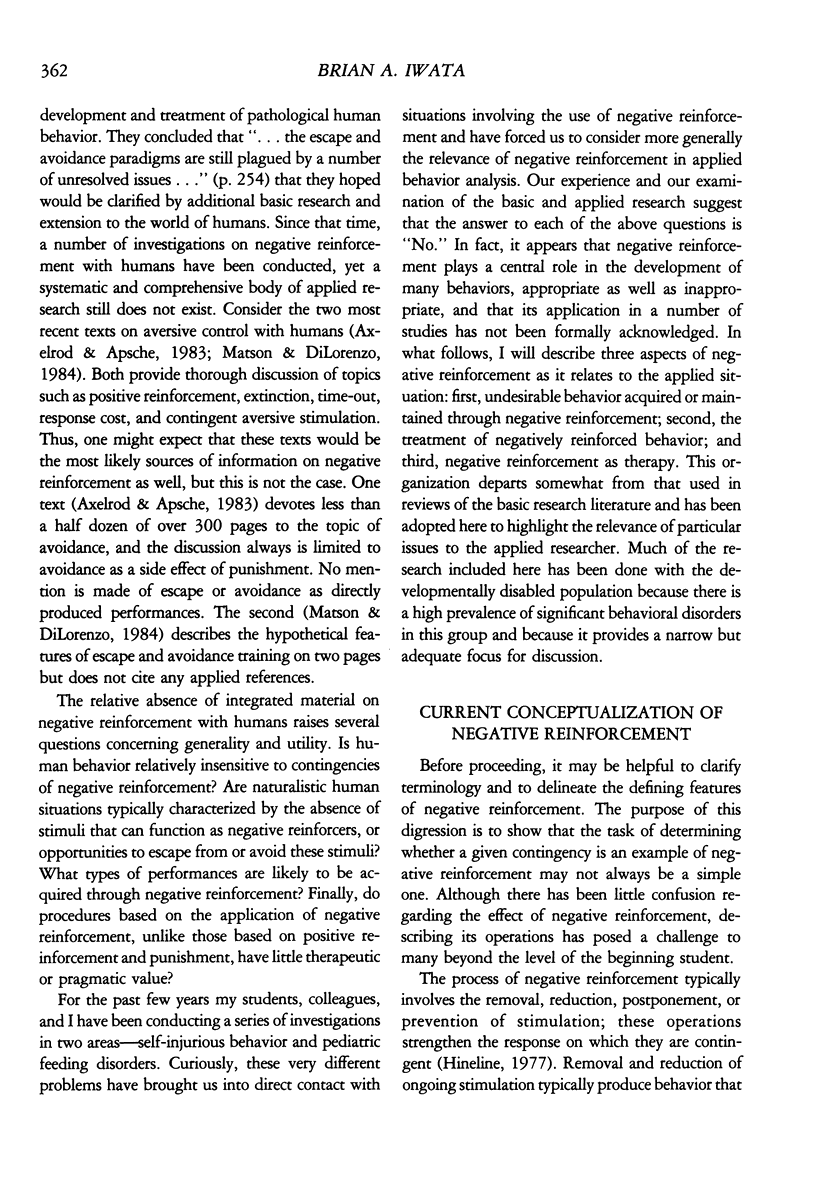
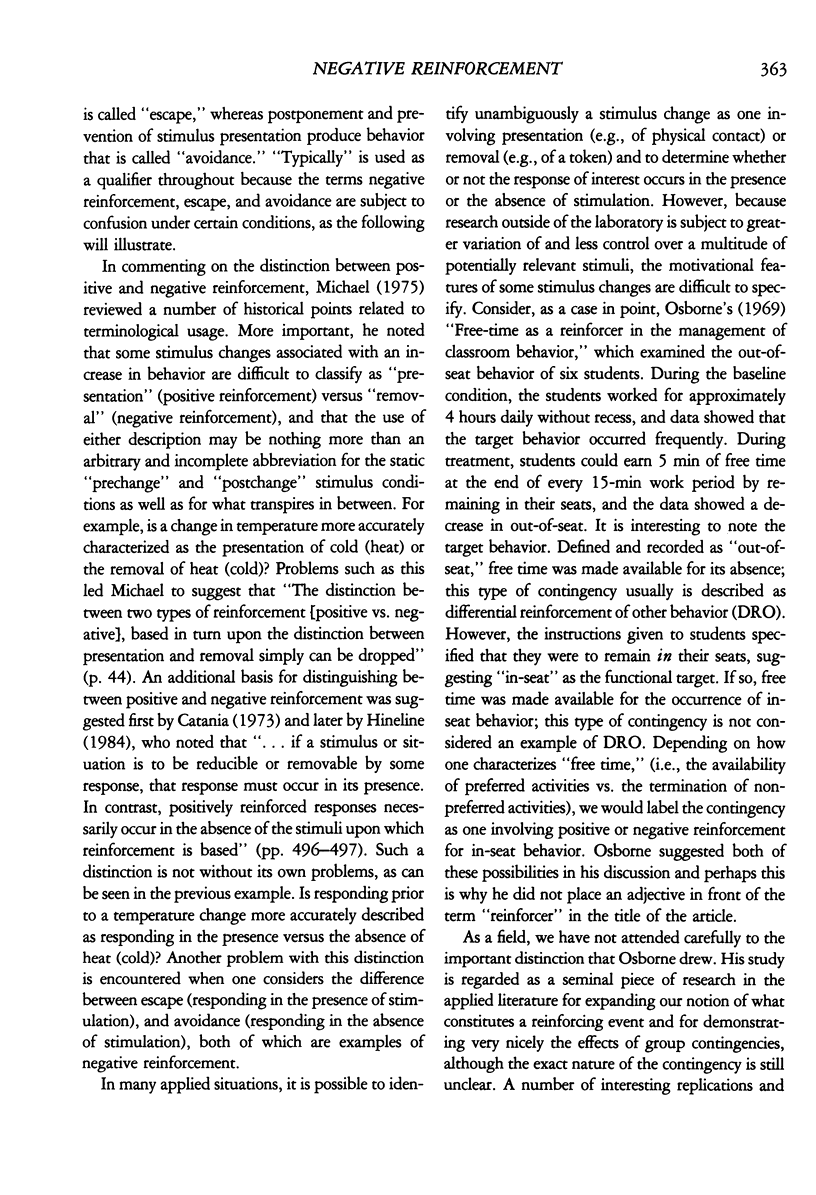

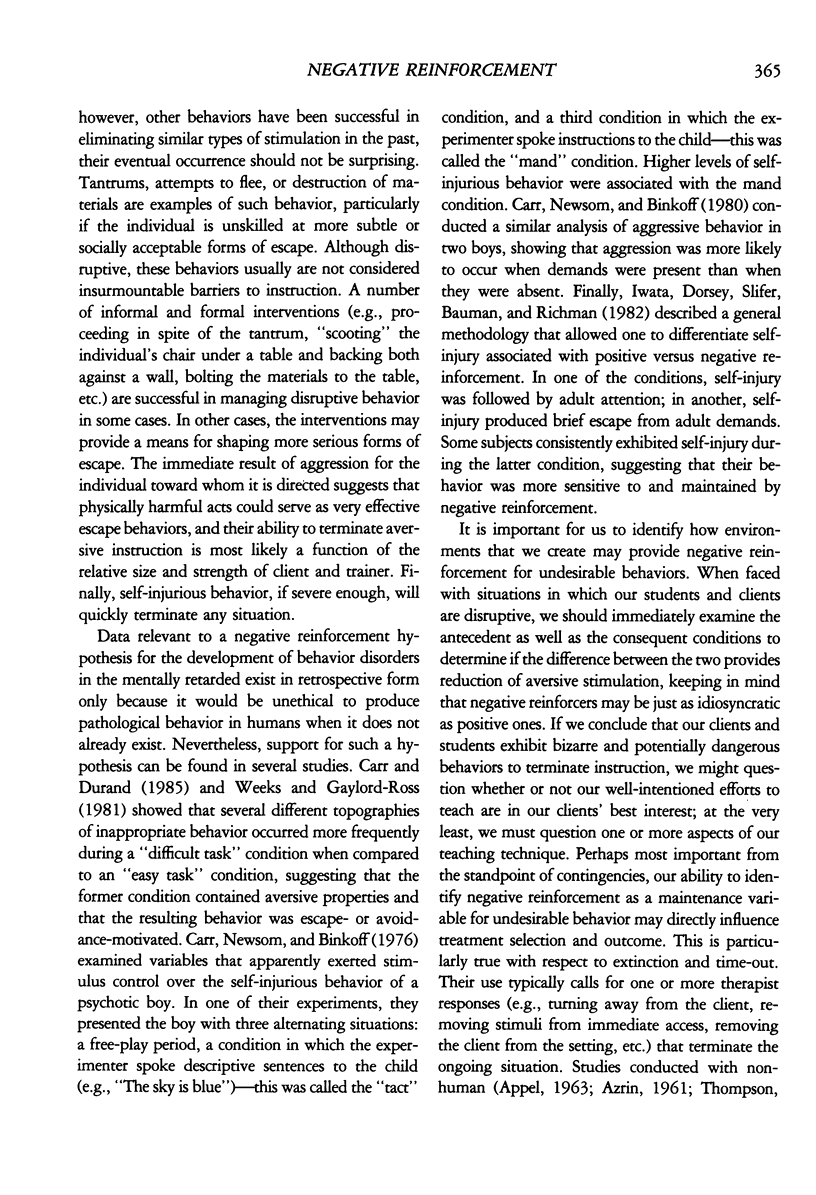
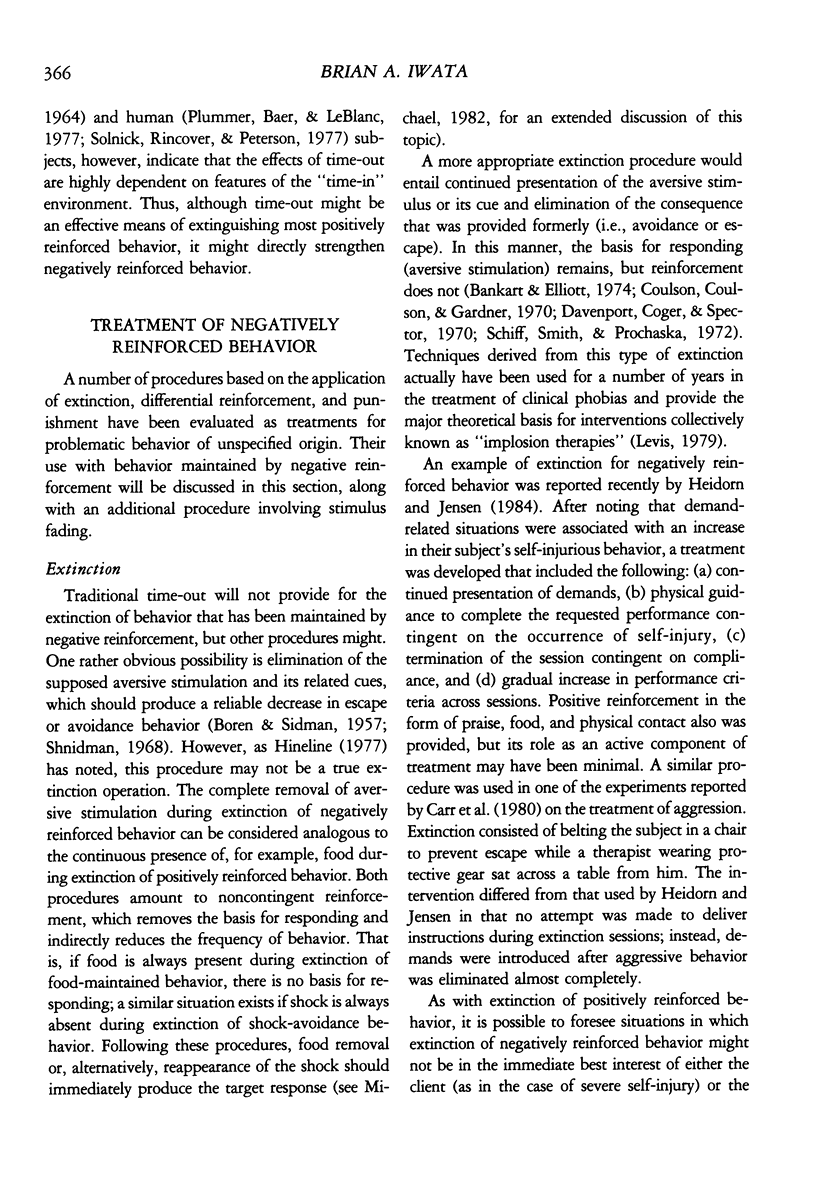






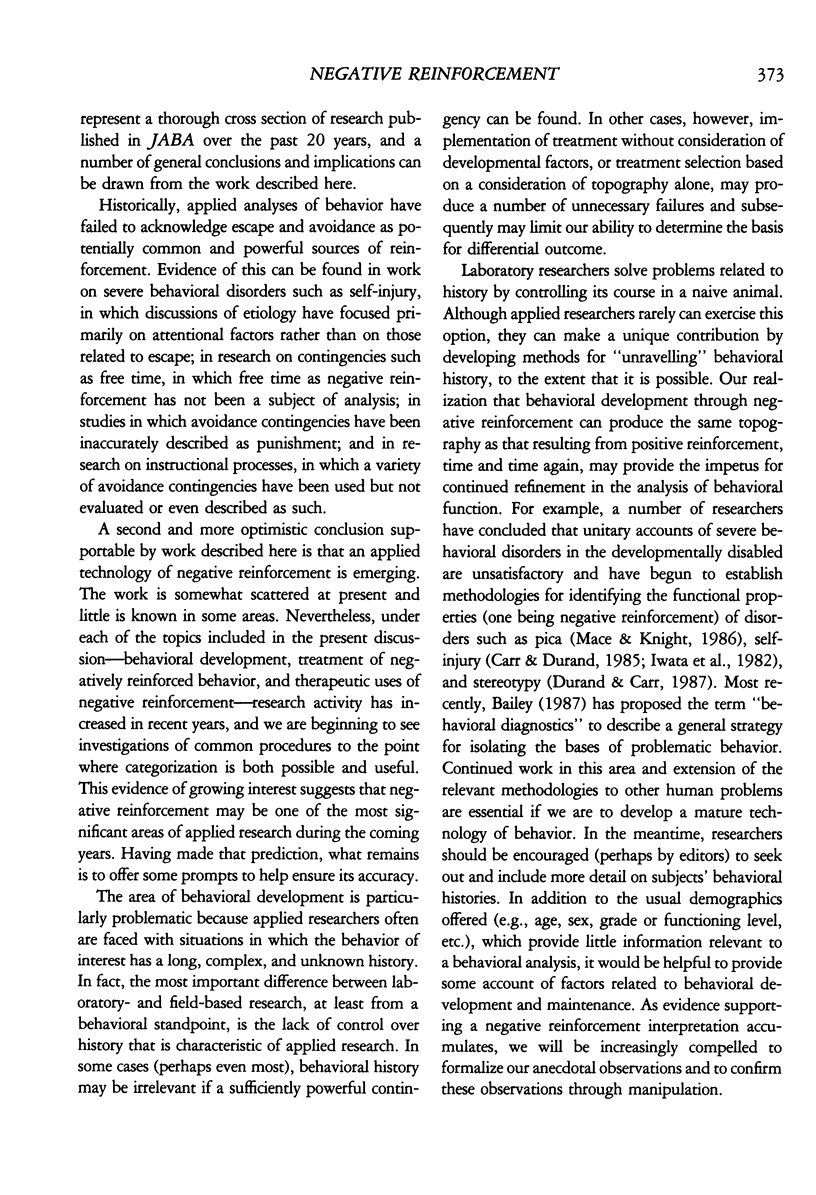
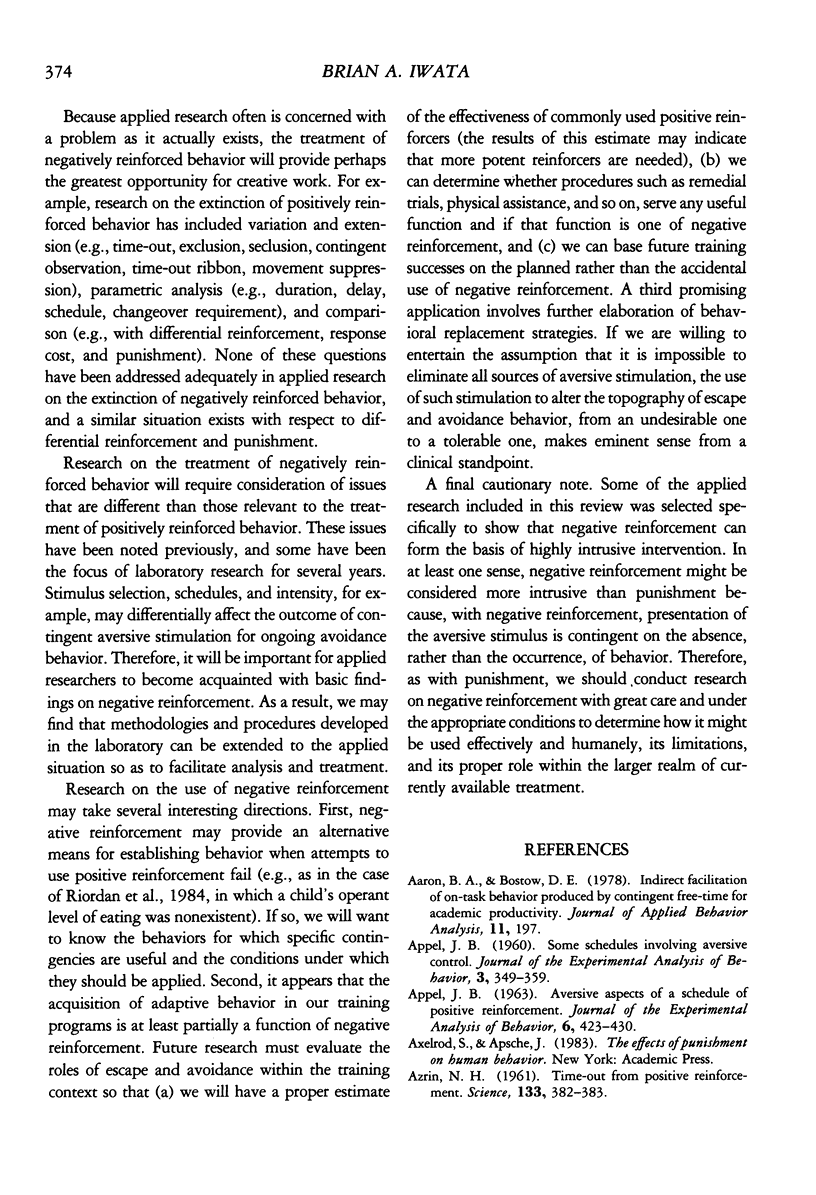
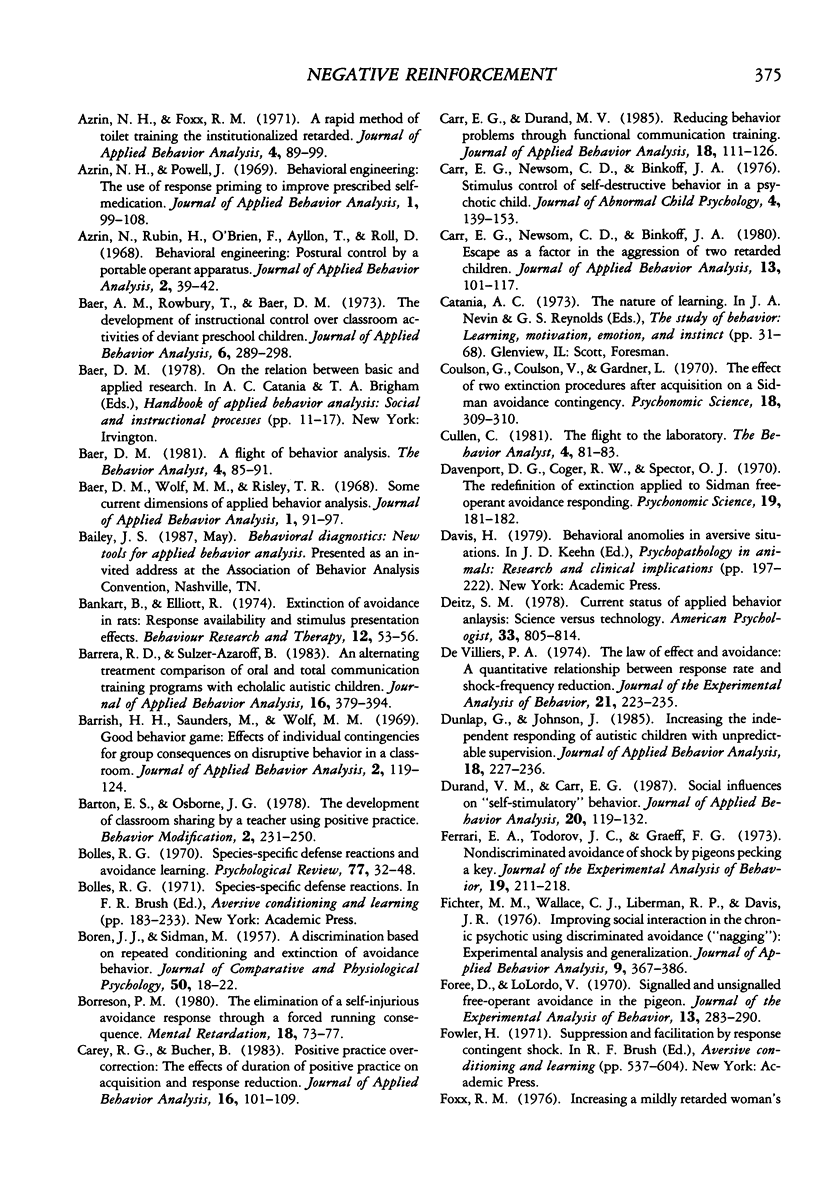

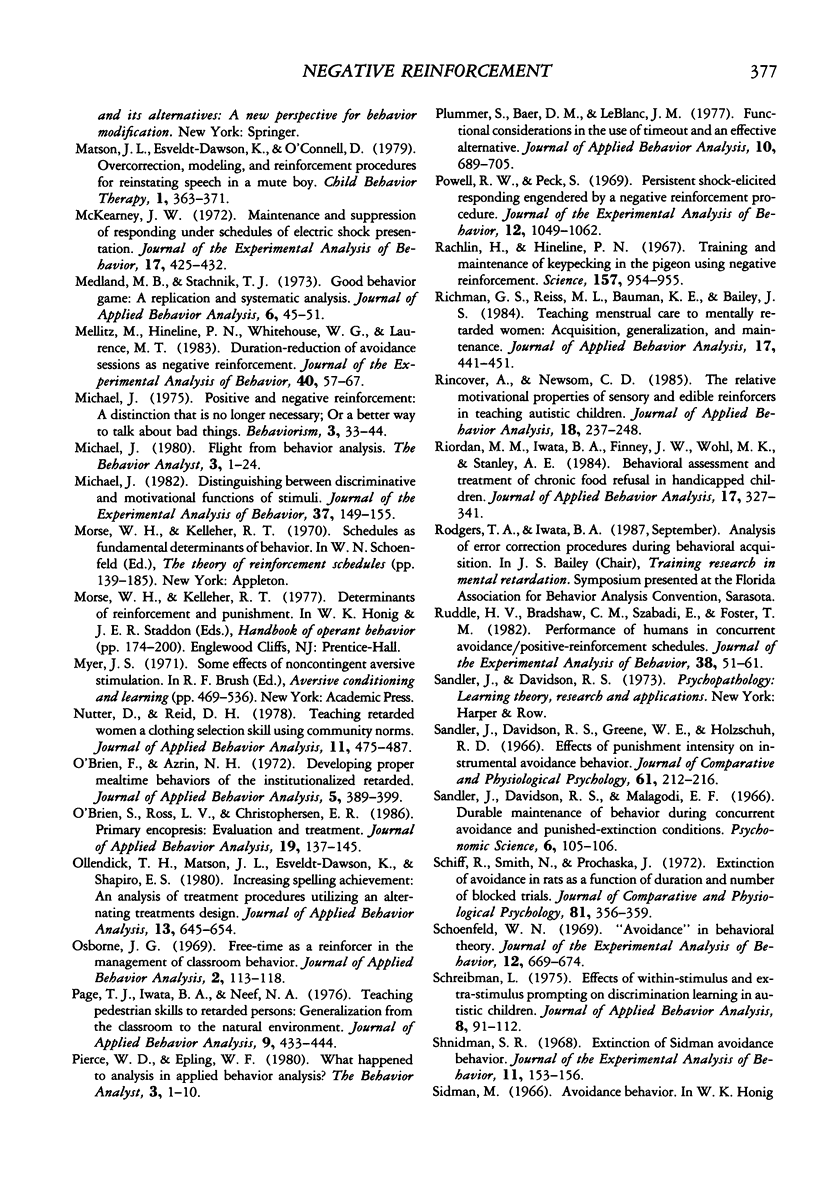

Selected References
These references are in PubMed. This may not be the complete list of references from this article.
- APPEL J. B. Aversive aspects of a schedule of positive reinforcement. J Exp Anal Behav. 1963 Jul;6:423–428. doi: 10.1901/jeab.1963.6-423. [DOI] [PMC free article] [PubMed] [Google Scholar]
- APPEL J. B. Some schedules involving aversive control. J Exp Anal Behav. 1960 Oct;3:349–359. doi: 10.1901/jeab.1960.3-349. [DOI] [PMC free article] [PubMed] [Google Scholar]
- AZRIN N. H. Time-out from positive reinforcement. Science. 1961 Feb 10;133(3450):382–383. doi: 10.1126/science.133.3450.382. [DOI] [PubMed] [Google Scholar]
- Azrin N. H., Foxx R. M. A rapid method of toilet training the institutionalized retarded. J Appl Behav Anal. 1971 Summer;4(2):89–99. doi: 10.1901/jaba.1971.4-89. [DOI] [PMC free article] [PubMed] [Google Scholar]
- Azrin N. H., Powell J. Behavioral engineering: the use of response priming to improve prescribed self-medication. J Appl Behav Anal. 1969 Spring;2(1):39–42. doi: 10.1901/jaba.1969.2-39. [DOI] [PMC free article] [PubMed] [Google Scholar]
- Azrin N., Rubin H., O'brien F., Ayllon T., Roll D. Behavioral engineering: postural control by a portable operant apparatus. J Appl Behav Anal. 1968 Summer;1(2):99–108. doi: 10.1901/jaba.1968.1-99. [DOI] [PMC free article] [PubMed] [Google Scholar]
- BOREN J. J., SIDMAN M. A discrimination based upon repeated conditioning and extinction of avoidance behavior. J Comp Physiol Psychol. 1957 Feb;50(1):18–22. doi: 10.1037/h0045142. [DOI] [PubMed] [Google Scholar]
- Baer A. M., Rowbury T., Baer D. M. The development of instructional control over classroom activities of deviant preschool children. J Appl Behav Anal. 1973 Summer;6(2):289–298. doi: 10.1901/jaba.1973.6-289. [DOI] [PMC free article] [PubMed] [Google Scholar]
- Baer D. M., Wolf M. M., Risley T. R. Some current dimensions of applied behavior analysis. J Appl Behav Anal. 1968 Spring;1(1):91–97. doi: 10.1901/jaba.1968.1-91. [DOI] [PMC free article] [PubMed] [Google Scholar]
- Bankart B., Elliott R. Extinction of avoidance in rats: response availability and stimulus presentation effects. Behav Res Ther. 1974 Feb;12(1):53–56. doi: 10.1016/0005-7967(74)90031-x. [DOI] [PubMed] [Google Scholar]
- Barrera R. D., Sulzer-Azaroff B. An alternating treatment comparison of oral and total communications training programs with echolalic autistic children. J Appl Behav Anal. 1983 Winter;16(4):379–394. doi: 10.1901/jaba.1983.16-379. [DOI] [PMC free article] [PubMed] [Google Scholar]
- Barrish H. H., Saunders M., Wolf M. M. Good behavior game: effects of individual contingencies for group consequences on disruptive behavior in a classroom. J Appl Behav Anal. 1969 Summer;2(2):119–124. doi: 10.1901/jaba.1969.2-119. [DOI] [PMC free article] [PubMed] [Google Scholar]
- Borreson P. M. The elimination of a self-injurious avoidance response through a forced running consequence. Ment Retard. 1980 Apr;18(2):73–77. [PubMed] [Google Scholar]
- Carey R. G., Bucher B. Positive practice overcorrection: the effects of duration of positive practice on acquisition and response reduction. J Appl Behav Anal. 1983 Spring;16(1):101–109. doi: 10.1901/jaba.1983.16-101. [DOI] [PMC free article] [PubMed] [Google Scholar]
- Carr E. G., Durand V. M. Reducing behavior problems through functional communication training. J Appl Behav Anal. 1985 Summer;18(2):111–126. doi: 10.1901/jaba.1985.18-111. [DOI] [PMC free article] [PubMed] [Google Scholar]
- Carr E. G., Newsom C. D., Binkoff J. A. Escape as a factor in the aggressive behavior of two retarded children. J Appl Behav Anal. 1980 Spring;13(1):101–117. doi: 10.1901/jaba.1980.13-101. [DOI] [PMC free article] [PubMed] [Google Scholar]
- Carr E. G., Newsom C. D., Binkoff J. A. Stimulus control of self-destructive behavior in a psychotic child. J Abnorm Child Psychol. 1976;4(2):139–153. doi: 10.1007/BF00916518. [DOI] [PubMed] [Google Scholar]
- De Villiers P. A. The law of effect and avoidance: a quantitative relationship between response rate and shock-frequency reduction. J Exp Anal Behav. 1974 Mar;21(2):223–235. doi: 10.1901/jeab.1974.21-223. [DOI] [PMC free article] [PubMed] [Google Scholar]
- Dunlap G., Johnson J. Increasing the independent responding of autistic children with unpredictable supervision. J Appl Behav Anal. 1985 Fall;18(3):227–236. doi: 10.1901/jaba.1985.18-227. [DOI] [PMC free article] [PubMed] [Google Scholar]
- Durand V. M., Carr E. G. Social influences on "self-stimulatory" behavior: analysis and treatment application. J Appl Behav Anal. 1987 Summer;20(2):119–132. doi: 10.1901/jaba.1987.20-119. [DOI] [PMC free article] [PubMed] [Google Scholar]
- Ferrari E. A., Todorov J. C., Graeff F. G. Nondiscriminated avoidance of shock by pigeons pecking a key. J Exp Anal Behav. 1973 Mar;19(2):211–218. doi: 10.1901/jeab.1973.19-211. [DOI] [PMC free article] [PubMed] [Google Scholar]
- Fichter M. M., Wallace C. J., Liberman R. P., Davis J. R. Improving social interaction in chronic psychotic using discriminated avoidance ("nagging"): experimental analysis and generalization. J Appl Behav Anal. 1976 WINTER;9(4):377–386. doi: 10.1901/jaba.1976.9-377. [DOI] [PMC free article] [PubMed] [Google Scholar]
- Foree D. D., Lolordo V. M. Signalled and unsignalled free-operant avoidance in the pigeon. J Exp Anal Behav. 1970 May;13(3):283–290. doi: 10.1901/jeab.1970.13-283. [DOI] [PMC free article] [PubMed] [Google Scholar]
- Foxx R. M. Attention training: the use of overcorrection avoidance to increase the eye contact of autistic and retarded children. J Appl Behav Anal. 1977 Fall;10(3):489–499. doi: 10.1901/jaba.1977.10-489. [DOI] [PMC free article] [PubMed] [Google Scholar]
- Greene R. J., Hoats D. L. Reinforcing capabilities of television distortion. J Appl Behav Anal. 1969 Summer;2(2):139–141. doi: 10.1901/jaba.1969.2-139. [DOI] [PMC free article] [PubMed] [Google Scholar]
- HERRNSTEIN R. J. Relative and absolute strength of response as a function of frequency of reinforcement. J Exp Anal Behav. 1961 Jul;4:267–272. doi: 10.1901/jeab.1961.4-267. [DOI] [PMC free article] [PubMed] [Google Scholar]
- Hansen G. D. Enuresis control through fading, escape, and avoidance training. J Appl Behav Anal. 1979 Summer;12(2):303–307. doi: 10.1901/jaba.1979.12-303. [DOI] [PMC free article] [PubMed] [Google Scholar]
- Haring T. G. Teaching between-class generalization of toy play behavior to handicapped children. J Appl Behav Anal. 1985 Summer;18(2):127–139. doi: 10.1901/jaba.1985.18-127. [DOI] [PMC free article] [PubMed] [Google Scholar]
- Harris V. W., Sherman J. A. Homework assignments, consequences, and classroom performance in social studies and mathematics. J Appl Behav Anal. 1974 Winter;7(4):505–519. doi: 10.1901/jaba.1974.7-505. [DOI] [PMC free article] [PubMed] [Google Scholar]
- Harris V. W., Sherman J. A. Use and analysis of the "Good Behavior Game" to reduce disruptive classroom behavior. J Appl Behav Anal. 1973 Fall;6(3):405–417. doi: 10.1901/jaba.1973.6-405. [DOI] [PMC free article] [PubMed] [Google Scholar]
- Heidorn S. D., Jensen C. C. Generalization and maintenance of the reduction of self-injurious behavior maintained by two types of reinforcement. Behav Res Ther. 1984;22(5):581–586. doi: 10.1016/0005-7967(84)90062-7. [DOI] [PubMed] [Google Scholar]
- Herrnstein R. J. Method and theory in the study of avoidance. Psychol Rev. 1969 Jan;76(1):49–69. doi: 10.1037/h0026786. [DOI] [PubMed] [Google Scholar]
- Hineline P. N. Aversive control: A separate domain? J Exp Anal Behav. 1984 Nov;42(3):495–509. doi: 10.1901/jeab.1984.42-495. [DOI] [PMC free article] [PubMed] [Google Scholar]
- KELLEHER R. T., RIDDLE W. C., COOK L. PERSISTENT BEHAVIOR MAINTAINED BY UNAVOIDABLE SHOCKS. J Exp Anal Behav. 1963 Oct;6:507–517. doi: 10.1901/jeab.1963.6-507. [DOI] [PMC free article] [PubMed] [Google Scholar]
- Kelleher R. T., Morse W. H. Schedules using noxious stimuli. III. Responding maintained with response-produced electric shocks. J Exp Anal Behav. 1968 Nov;11(6):819–838. doi: 10.1901/jeab.1968.11-819. [DOI] [PMC free article] [PubMed] [Google Scholar]
- Kelley M. L., Jarvie G. J., Middlebrook J. L., McNeer M. F., Drabman R. S. Decreasing burned children's pain behavior: impacting the trauma of hydrotherapy. J Appl Behav Anal. 1984 Summer;17(2):147–158. doi: 10.1901/jaba.1984.17-147. [DOI] [PMC free article] [PubMed] [Google Scholar]
- Kircher A. S., Pear J. J., Martin G. L. Shock as punishment in a picture-naming task with retarded children. J Appl Behav Anal. 1971 Fall;4(3):227–233. doi: 10.1901/jaba.1971.4-227. [DOI] [PMC free article] [PubMed] [Google Scholar]
- Krasnegor N. A., Brady J. V., Findley J. D. Second-order optional avoidance as a function of fixed-ratio requirements. J Exp Anal Behav. 1971 Mar;15(2):181–187. doi: 10.1901/jeab.1971.15-181. [DOI] [PMC free article] [PubMed] [Google Scholar]
- Long J. D., Williams R. L. The comparative effectiveness of group and individually contingent free time with inner-city junior high school students. J Appl Behav Anal. 1973 Fall;6(3):465–474. doi: 10.1901/jaba.1973.6-465. [DOI] [PMC free article] [PubMed] [Google Scholar]
- Luyben P. D., Funk D. M., Morgan J. K., Clark K. A., Delulio D. W. Team sports for the severely retarded: training a side-of-the-foot soccer pass using a maximum-to-minimum prompt reduction strategy. J Appl Behav Anal. 1986 Winter;19(4):431–436. doi: 10.1901/jaba.1986.19-431. [DOI] [PMC free article] [PubMed] [Google Scholar]
- Mace F. C., Knight D. Functional analysis and treatment of severe pica. J Appl Behav Anal. 1986 Winter;19(4):411–416. doi: 10.1901/jaba.1986.19-411. [DOI] [PMC free article] [PubMed] [Google Scholar]
- Macphail E. M. Avoidance responding in pigeons. J Exp Anal Behav. 1968 Sep;11(5):629–632. doi: 10.1901/jeab.1968.11-629. [DOI] [PMC free article] [PubMed] [Google Scholar]
- Maloney K. B., Hopkins B. L. The modification of sentence structure and its relationship to subjective judgements of creativity in writing. J Appl Behav Anal. 1973 Fall;6(3):425–433. doi: 10.1901/jaba.1973.6-425. [DOI] [PMC free article] [PubMed] [Google Scholar]
- McKearney J. W. Maintenance and suppression of responding under schedules of electric shock presentation. J Exp Anal Behav. 1972 May;17(3):425–432. doi: 10.1901/jeab.1972.17-425. [DOI] [PMC free article] [PubMed] [Google Scholar]
- Mellitz M., Hineline P. N., Whitehouse W. G., Laurence M. T. Duration-reduction of avoidance sessions as negative reinforcement. J Exp Anal Behav. 1983 Jul;40(1):57–67. doi: 10.1901/jeab.1983.40-57. [DOI] [PMC free article] [PubMed] [Google Scholar]
- Michael J. Distinguishing between discriminative and motivational functions of stimuli. J Exp Anal Behav. 1982 Jan;37(1):149–155. doi: 10.1901/jeab.1982.37-149. [DOI] [PMC free article] [PubMed] [Google Scholar]
- Nutter D., Reid D. H. Teaching retarded women a clothing selection skill using community norms. J Appl Behav Anal. 1978 Winter;11(4):475–487. doi: 10.1901/jaba.1978.11-475. [DOI] [PMC free article] [PubMed] [Google Scholar]
- O'Brien S., Ross L. V., Christophersen E. R. Primary encopresis: evaluation and treatment. J Appl Behav Anal. 1986 Summer;19(2):137–145. doi: 10.1901/jaba.1986.19-137. [DOI] [PMC free article] [PubMed] [Google Scholar]
- O'brien F., Azrin N. H. Developing proper mealtime behaviors of the institutionalized retarded. J Appl Behav Anal. 1972 Winter;5(4):389–399. doi: 10.1901/jaba.1972.5-389. [DOI] [PMC free article] [PubMed] [Google Scholar]
- Ollendick T. H., Matson J. L., Esveldt-Dawson K., Shapiro E. S. Increasing spelling achievement: an analysis of treatment procedures utilizing an alternating treatments design. J Appl Behav Anal. 1980 Winter;13(4):645–654. doi: 10.1901/jaba.1980.13-645. [DOI] [PMC free article] [PubMed] [Google Scholar]
- Osborne J. G. Free-time as a reinforcer in the management of classroom behavior. J Appl Behav Anal. 1969 Summer;2(2):113–118. doi: 10.1901/jaba.1969.2-113. [DOI] [PMC free article] [PubMed] [Google Scholar]
- doi: 10.1901/jaba.1978.11-197. [DOI] [PMC free article] [Google Scholar]
- Page T. J., Iwata B. A., Neef N. A. Teaching pedestrian skills to retarded persons: generalization from the classroom to the natural environment. J Appl Behav Anal. 1976 WINTER;9(4):433–444. doi: 10.1901/jaba.1976.9-433. [DOI] [PMC free article] [PubMed] [Google Scholar]
- Plummer S., Baer D. M., LeBlanc J. M. Functional considerations in the use of procedural timeout and in effective alternative. J Appl Behav Anal. 1977 Winter;10(4):689–705. doi: 10.1901/jaba.1977.10-689. [DOI] [PMC free article] [PubMed] [Google Scholar]
- Powell R. W., Peck S. Persistent shock-elicited responding engendered by a negative-reinforcement procedure. J Exp Anal Behav. 1969 Nov;12(6):1049–1062. doi: 10.1901/jeab.1969.12-1049. [DOI] [PMC free article] [PubMed] [Google Scholar]
- Rachlin H., Hineline P. N. Training and maintenance of keypecking in the pigeon by negative reinforcement. Science. 1967 Aug 25;157(3791):954–955. doi: 10.1126/science.157.3791.954. [DOI] [PubMed] [Google Scholar]
- Richman G. S., Reiss M. L., Bauman K. E., Bailey J. S. Teaching menstrual care to mentally retarded women: acquisition, generalization, and maintenance. J Appl Behav Anal. 1984 Winter;17(4):441–451. doi: 10.1901/jaba.1984.17-441. [DOI] [PMC free article] [PubMed] [Google Scholar]
- Rincover A., Newsom C. D. The relative motivational properties of sensory and edible reinforcers in teaching autistic children. J Appl Behav Anal. 1985 Fall;18(3):237–248. doi: 10.1901/jaba.1985.18-237. [DOI] [PMC free article] [PubMed] [Google Scholar]
- Riordan M. M., Iwata B. A., Finney J. W., Wohl M. K., Stanley A. E. Behavioral assessment and treatment of chronic food refusal in handicapped children. J Appl Behav Anal. 1984 Fall;17(3):327–341. doi: 10.1901/jaba.1984.17-327. [DOI] [PMC free article] [PubMed] [Google Scholar]
- Ruddle H. V., Bradshaw C. M., Szabadi E., Foster T. M. Performance of humans in concurrent avoidance/positive-reinforcement schedules. J Exp Anal Behav. 1982 Jul;38(1):51–61. doi: 10.1901/jeab.1982.38-51. [DOI] [PMC free article] [PubMed] [Google Scholar]
- SIDMAN M., HERRNSTEIN R. J., CONRAD D. G. Maintenance of avoidance behavior by unavoidable shocks. J Comp Physiol Psychol. 1957 Dec;50(6):553–557. doi: 10.1037/h0043500. [DOI] [PubMed] [Google Scholar]
- Sandler J., Davidson R. S., Greene W. E., Holzschuh R. D. Effects of punishment intensity on instrumental avoidance behavior. J Comp Physiol Psychol. 1966 Apr;61(2):212–216. doi: 10.1037/h0023149. [DOI] [PubMed] [Google Scholar]
- Schiff R., Smith N., Prochaska J. Extinction of avoidance in rats as a function of duration and number of blocked trials. J Comp Physiol Psychol. 1972 Nov;81(2):356–359. doi: 10.1037/h0033540. [DOI] [PubMed] [Google Scholar]
- Schoenfeld W. N. "Avoidance" in behavior theory. J Exp Anal Behav. 1969 Jul;12(4):669–674. doi: 10.1901/jeab.1969.12-669. [DOI] [PMC free article] [PubMed] [Google Scholar]
- Schreibman L. Effects of within-stimulus and extra-stimulus prompting on discrimination learning in autistic children. J Appl Behav Anal. 1975 Spring;8(1):91–112. doi: 10.1901/jaba.1975.8-91. [DOI] [PMC free article] [PubMed] [Google Scholar]
- Shnidman S. R. Extinction of Sidman avoidance behavior. J Exp Anal Behav. 1968 Mar;11(2):153–156. doi: 10.1901/jeab.1968.11-153. [DOI] [PMC free article] [PubMed] [Google Scholar]
- Smith R. F., Keller F. R. Free-operant avoidance in the pigeon using a treadle response. J Exp Anal Behav. 1970 Mar;13(2):211–214. doi: 10.1901/jeab.1970.13-211. [DOI] [PMC free article] [PubMed] [Google Scholar]
- Solnick J. V., Rincover A., Peterson C. R. Some determinants of the reinforcing and punishing effects of timeout. J Appl Behav Anal. 1977 Fall;10(3):415–424. doi: 10.1901/jaba.1977.10-415. [DOI] [PMC free article] [PubMed] [Google Scholar]
- Sprague J. R., Horner R. H. The effects of single instance, multiple instance, and general case training on generalized vending machine use by moderately and severely handicapped students. J Appl Behav Anal. 1984 Summer;17(2):273–278. doi: 10.1901/jaba.1984.17-273. [DOI] [PMC free article] [PubMed] [Google Scholar]
- THOMPSON D. M. ESCAPE FROM SD ASSOCIATED WITH FIXED-RATIO REINFORCEMENT. J Exp Anal Behav. 1964 Jan;7:1–8. doi: 10.1901/jeab.1964.7-1. [DOI] [PMC free article] [PubMed] [Google Scholar]
- Weeks M., Gaylord-Ross R. Task difficulty and aberrant behavior in severely handicapped students. J Appl Behav Anal. 1981 Winter;14(4):449–463. doi: 10.1901/jaba.1981.14-449. [DOI] [PMC free article] [PubMed] [Google Scholar]


